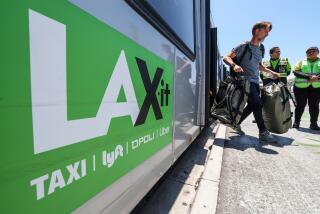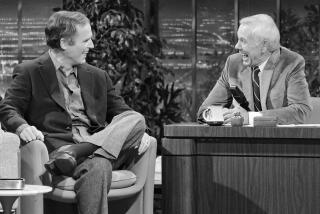Reports for FAA Show Airport Has Cut Noise : Burbank: Passenger volume is up, but the area exposed to din is found to be smaller. A homeowner group’s co-founder dismisses the findings.
- Share via
It was a noisy affair.
About 160 neighbors of Burbank Airport, as well as Los Angeles City Councilmen Zev Yaroslavsky and Joel Wachs, met in September at a North Hollywood hotel for a public hearing on a plan to build a new terminal that would serve about 40% more passengers.
Most of the speakers said the daily din of jet engines had frayed their nerves, rattled dishes off kitchen shelves and awakened children at night--as evidenced by an increase of more than 200% in the number of noise complaints to the airport in the past four years.
A new terminal, many residents argued, would mean more passengers, more flights and ultimately more noise.
But that has not been the trend at Burbank Airport--at least judging by standardized state noise measurements done for the federal government.
Although passenger volume has increased by nearly 65% since the cities of Burbank, Glendale and Pasadena purchased the airport in 1978, the number of landings and takeoffs has dropped by 25%. And the residential area around the airport exposed to noise levels classified as excessive--as defined by a common federal airport noise measurement--has shrunk by about 95%.
The reason: the growing use of larger jets that carry more passengers but use quieter, more advanced engines.
The key factor “is pretty much exclusively that the planes flying today are quieter than those flying in the ‘70s and ‘80s,” said John Mills, a supervisor at Acoustical Analysis Associates Inc., a Canoga Park firm that conducts state standardized noise readings at Burbank Airport. The quarterly readings are required for every airport by the Federal Aviation Administration.
In fact, FAA officials say local and federal laws designed to phase out older, noisier jets are helping to reduce noise around airports nationwide.
They cite as another example John Wayne Airport in Orange County, where the area around the airport exposed to significant noise levels has shrunk by about 75% over the past 10 years. During the same period, passenger volume has more than doubled, from 2.5 million passengers in 1982 to an estimated 5.7 million in 1992, airport spokeswoman Courtney Wiercioch said.
“The decrease relates mostly to the improvements in aircraft technology,” she said.
A 1990 federal noise policy calls for airlines nationwide to phase out older, noisier jet engines--designated by the FAA as Stage 2 units--and replace them with newer, quieter Stage 3 jets by the year 2000. Stage 3 jets are generally about 10 decibels quieter than the older ones, noise experts say.
But Burbank Airport is one of the few airports in the nation that in 1987 reached an agreement with its airlines to immediately eliminate--with few exceptions--the Stage 2 jets. Burbank Airport also has a 10 p.m. to 7 a.m. curfew on scheduled airline traffic.
The agreement apparently had an effect on noise.
When the three cities purchased the airport 15 years ago, noise readings showed that a 403-acre residential area around the airport was regularly exposed to noise measuring more than 70 decibels. That area has shrunk to less than 28 acres, according to noise readings for the first three months of 1992.
Noise measuring 70 decibels falls between the volume of normal conversation heard three feet away--about 65 decibels--and a typical jackhammer heard from 50 feet away--88 decibels.
The number of landings and takeoffs at Burbank Airport has decreased about 25% from 293,810 in 1978 to 224,033 in 1991, according to airport officials. But the number of passengers has increased about 65%, from 2.25 million in 1978 to 3.78 million during the 1991-92 fiscal year, according to airport reports.
Despite the reported noise decrease, many Burbank Airport neighbors say they have noticed no relief. In fact, they believe that the airport generates more clamor than ever.
And they have voiced their concerns in large numbers: In 1989, the airport received 340 noise complaints. In 1992, the number shot up to 1,056, according to airport officials.
“It’s worse than it’s ever been,” said Jim Gordon of Burbank, co-founder of the Burbank Flatlanders, a homeowner group that has been among the most vociferous of airport critics.
“I don’t care how they shuffle the deck; when they deal out the cards, we get the losing hand.”
Gordon said he doesn’t trust the evidence offered by airport officials that indicates noise is declining.
“I don’t believe a damn word they say,” he said. “If I had the money that the airport has, I could make the airport neighbors believe anything I wanted them to believe.”
Gordon said noise levels will take off once the new, larger terminal is built. “My expertise is from living here for the last 23 years,” he said.
Plans for a new terminal at Burbank Airport have been in the making since 1980, when the FAA began to pressure airport officials to replace the present building, opened in 1930, which is closer to the runway than modern safety regulations allow.
Several airport officials have said they favor a plan for a two-level, 670,000-square-foot facility on about 140 acres of land on the northeast boundary of the airport. The new facility would accommodate the 5.4 million passengers expected to use the airport annually by 1998, according to an environmental report on the terminal expansion.
The Burbank Airport authority is expected to select a terminal plan next month.
Tom Paterson, an outspoken airport noise critic and member of the Valley Village Homeowners Assn., acknowledges that the new jets may be decreasing noise at the airport, but he fears that the airport will begin to fly even larger, noisier jets more often to increase its revenues to pay for the new terminal.
“They are talking about a different mission for the airport in the future,” he said.
Noise experts say it is not surprising for the number of complaints to increase while noise measurements show a decrease. They say volume is not the only factor when people determine whether a noise is annoying or not.
Since World War II, psychoacoustic experts have conducted dozens of surveys to determine the relationship between noise and a community’s annoyance level. They have concluded that many factors contribute to the annoyance level, including the noise frequency, duration, source and the time noise occurs. A person exposed to noise is also influenced by his or her attitude toward the noise source--in this case, the airport--they said.
“Decades of psychoacoustic research have demonstrated that it is unreasonable to expect pure physical measures to provide a complete, realistic account for the attitude of noise-induced annoyance,” Sanford Fidell, a Canoga Park-based psychoacoustic expert, said in a report published in 1990 for a noise conference at the University of Texas.
Mills agreed. “The noise monitoring we’ve been doing has shown that the noise level has indeed declined, but people’s reactions are dependent on a lot of different factors,” he said.
Burbank Airport spokesman Victor Gill said the new, quieter aircraft being phased in generate a high-pitched whine compared with the low rumble made by the older, louder planes. Even though the noise is not as loud, he said, residents may find the higher pitch more annoying.
Another possible factor for the increase in complaints, Gill said, is the noise footprint--the area on the ground exposed to noise--which shifts slightly as different planes use different departure patterns. He said such shifts may decrease noise in one area but increase it over the home of someone who wasn’t bothered by noise in the past and who now complains that noise has increased.
“There really is no reliable correlation between the public’s sensitivity and the number of operations,” he said.
But he said political factors also come into play. He noted that noise complaints more than tripled from 72 in August to 223 in September, the month public hearings were held on the new terminal.
“Unfortunately, it hinges on one’s definition of quiet,” Gill said. “No two people seem to agree on what is noise. But under the system that prevails in California . . . we’ve done a really, really good job.”
More to Read
Sign up for Essential California
The most important California stories and recommendations in your inbox every morning.
You may occasionally receive promotional content from the Los Angeles Times.











